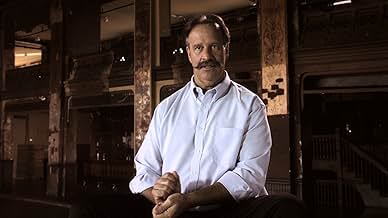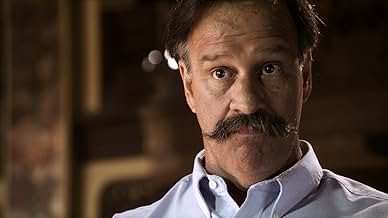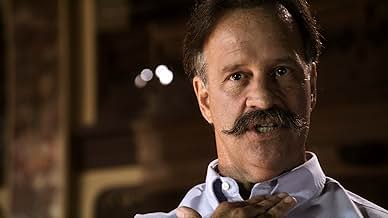NOTE IMDb
6,3/10
2,2 k
MA NOTE
documentaire sur l'histoire du tueur Jeffrey Dahmerdocumentaire sur l'histoire du tueur Jeffrey Dahmerdocumentaire sur l'histoire du tueur Jeffrey Dahmer
- Réalisation
- Scénario
- Casting principal
- Récompenses
- 1 victoire et 2 nominations au total
Jeffrey Dahmer
- Self
- (images d'archives)
Avis à la une
Jeff had its world premiere at the SXSW Film Festival. The film paints an intriguing, even provocative, portrait on a man whose actions place him among pantheon of the most evil figures of our times alongside the Nazis in our collective memory. The use of interviews with a neighbor, a police investigator and a medical examiner paints a compelling picture of the events surrounding the arrest and prosecution of Jeffrey Dahmer. They also show us how the revelation of his crimes affected those around him. The interviews paint a powerful picture and deliver a solid portrait of the serial killer that provides us with interesting insights into Dahmer's twisted mind and personality.
However, the other aspect of Jeff is more problematic. The director felt the need to supplemental the interviews by recreating everyday aspects of Dahmer's life using actors to show bits and pieces of his daily life as he shops for stuff that he'll need to carry out his vicious crimes. These scenes present the absolute ordinariness and in-distinctiveness of Dahmer. The phrase that kept going through my mind was Hannah Arendt's famous phrase "the banality of evil" which she used to describe Adolf Eichmann during his Israeli war crimes trial. The director and writers seem to be trying to do something similar in this film. The problem is that in so doing they are taking the dangerous step of merging fact and fiction. It is unclear whether they are attempting to recreate actual events or just imagine how Dahmer might have behaved based on their own speculations. The line between reality and imagination has becomes very blurry when you mix documentation with dramatization.
However, the other aspect of Jeff is more problematic. The director felt the need to supplemental the interviews by recreating everyday aspects of Dahmer's life using actors to show bits and pieces of his daily life as he shops for stuff that he'll need to carry out his vicious crimes. These scenes present the absolute ordinariness and in-distinctiveness of Dahmer. The phrase that kept going through my mind was Hannah Arendt's famous phrase "the banality of evil" which she used to describe Adolf Eichmann during his Israeli war crimes trial. The director and writers seem to be trying to do something similar in this film. The problem is that in so doing they are taking the dangerous step of merging fact and fiction. It is unclear whether they are attempting to recreate actual events or just imagine how Dahmer might have behaved based on their own speculations. The line between reality and imagination has becomes very blurry when you mix documentation with dramatization.
Another year, another movie about American Serial Killer from Milwaukee. This documentary has some new information, but it also has some old information. I wished it didn't have the re-enactments because they were kinda corny. It goes into more details about the gruesome discoveries in Dahmer's apartment, and those sections are the most interesting. They also talk about Dahmer interrogation, his feelings, and how his crime has changed the life of everyone involved as well as the people of Milwaukee.
THE JEFFERY DAHMER FILES (dir. Chris James Thompson) A startlingly original dramatization and documentary about infamous Milwaukee serial killer, Jeffery Dahmer. The film features conversations with three interviewees; the detective who had first contact with Dahmer, the middle- aged, Afro American woman who was Dahmer's neighbor in the apartment building where his crimes were committed, and the medical examiner on the case. The fictionalized sections of the film augment and enhance the interrogative segments, and make this an authentic dramatic production and not just a series of interviews with 'talking heads'. The film is not even eighty minutes, but it is superbly edited and a brilliant example of documentary film-making. Well Worth a Look.
This starts off very slow to the point that I almost turned it off after a few minutes. However, when I saw that one of the speakers was the lead investigator on the Dahmer case, I continued to watch for a little while longer. And it was then that the documentary got interesting. This short movie follows the story of the lead investigator who interrogated Dahmer during his confession and how he corroborated with forensic investigators to determine just how many people Dahmer had killed. The deceive's and forensic's stories are good. The other chunk of the documentary interviews Dahmer's neighbor and a few others who knew him and their experience during his arrest. Although it offers another story/point of view to the case, it ultimately was not needed and made the picture feel slow and lackluster. The final chunk follows an actor playing the role of Dahmer just shopping and walking around so just reenacting his everyday life. This was absolutely a waste of footage and time. More footage of the Dahmer case would have been better to show in it's place.
An experimental documentary film that uses archival footage, interviews, and fictionalized scenarios to tell the story of the people around Jeffrey Dahmer during the summer of his arrest in 1991.
I like how they emphasized that Dahmer was a white guy in the black neighborhood, an wish this could have been explored more. Those not familiar with Milwaukee may not realize how incredibly segregated it is.
I further appreciated the story of the shirt, and plenty of other behind the scenes details from Detective Pat. Some may find it boring, but I think the idea of Pat just talking for two hours would be fascinating. He probably has other non-Dahmer stories to tell.
Using an actor to portray Dahmer was interesting. At first it seemed silly and unnecessary, but I understand why they went with it -- if you do not have the footage, you have to fill the screen with something.
I like how they emphasized that Dahmer was a white guy in the black neighborhood, an wish this could have been explored more. Those not familiar with Milwaukee may not realize how incredibly segregated it is.
I further appreciated the story of the shirt, and plenty of other behind the scenes details from Detective Pat. Some may find it boring, but I think the idea of Pat just talking for two hours would be fascinating. He probably has other non-Dahmer stories to tell.
Using an actor to portray Dahmer was interesting. At first it seemed silly and unnecessary, but I understand why they went with it -- if you do not have the footage, you have to fill the screen with something.
Le saviez-vous
- AnecdotesWon the Milwaukee Film Festival's Cream City Cinema Grand Jury Award for 2012.
- GaffesWhen Dahmer is purchasing alcohol in the convenient store, the "WE CARD" sticker on the freezer to the right says the "born on this date" year to purchase alcohol is 1990.
- Bandes originalesStill Light
Performed by The Knife
Meilleurs choix
Connectez-vous pour évaluer et suivre la liste de favoris afin de recevoir des recommandations personnalisées
- How long is The Jeffrey Dahmer Files?Alimenté par Alexa
Détails
Contribuer à cette page
Suggérer une modification ou ajouter du contenu manquant

Lacune principale
By what name was The Jeffrey Dahmer Files (2012) officially released in Canada in English?
Répondre

























